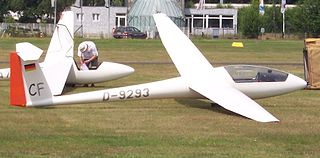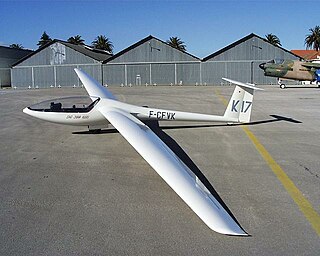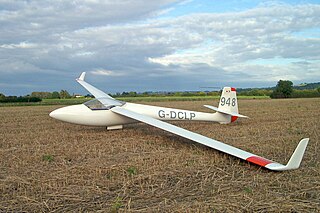
The Schempp-Hirth Discus is a Standard Class glider designed by Schempp-Hirth. It was produced in Germany between 1984 and 1995 but has continued in production in the Czech Republic. It replaced the Standard Cirrus. It was designed by Klaus Holighaus.

The Glaser-Dirks DG-200 is a 15 metre class glider built by Glaser-Dirks, now DG Aviation GmbH

The Rolladen-Schneider LS6 is a 15 metre and 18 metre single-seat flapped glider manufactured by Rolladen-Schneider Flugzeugbau GmbH between 1984 and 2003.

The Rolladen-Schneider LS3 is a 15 metre single-seat glider produced by Rolladen-Schneider from 1976 to 1983.

The LS11 or AFK1 is a prototype Two-Seater Class sailplane currently in development at Akaflieg Köln e.V.. The LS11 first flew on 5 November 2005.

The Rolladen-Schneider LS4 is a Standard Class single seat glider manufactured by Rolladen-Schneider Flugzeugbau GmbH between 1980 and 2003.

The Rolladen-Schneider LS2 is a 15-metre span single seat glider prototype with trailing-edge flaps, designed and built by Rolladen-Schneider Flugzeugbau GmbH c. 1973.

The Rolladen-Schneider LS1 is a Standard Class single-seat glider manufactured in Germany by Rolladen-Schneider from 1968 to 1977.

The Rolladen-Schneider LS8 is a Standard and 18 metre class single-seat glider developed by Rolladen-Schneider and in series production since 1995. Currently it is manufactured by DG Flugzeugbau.

The Rolladen-Schneider LS9 is an 18 metre single-seat motor glider launched in 2000 by Rolladen-Schneider. Production ended after just 10 gliders were built, when Rolladen-Schneider went into receivership.

The ASW 28 is a Standard Class glider with a fifteen-metre span built of modern fibre reinforced composites. The manufacturer of the ASW-28 is Alexander Schleicher GmbH & Co. The 'W' indicates this is a design of the influential and prolific German designer Gerhard Waibel. Serial production started in 2000.

The Glaser-Dirks DG-300 is a Standard Class single-seat high-performance glider built from glass-reinforced plastic. The DG-300 was designed by Wilhelm Dirks and manufactured by Glaser-Dirks Flugzeugbau's Slovenian partner company Elan (company). A total of 511 of all versions were built since production started in 1983. Representative contemporary types from competing manufacturers are the Rolladen-Schneider LS4 and the Schempp-Hirth Discus.
The Rolladen-Schneider LS10 is an 18 metre sailplane designed in Germany by Rolladen-Schneider. A prototype flew in 2003.

The Glasflügel 201 Standard Libelle is an early composite Standard Class single-seat sailplane produced by Glasflügel from 1967.

The ASW 24 is a modern single-seat high-performance composite Standard Class sailplane. It is manufactured in Germany by Alexander Schleicher GmbH & Co.

The ASW 19 is a single-seat glider built by Alexander Schleicher GmbH & Co, first flying in 1975. It was originally designed as a Standard Class glider, but now mainly competes in the Club Class. The ASW 19 is known for its pleasant handling and some clubs use it as a training glider. It was succeeded by the all-new Schleicher ASW 24.

The Glasflügel H-301 Libelle is an early composite single-seat sailplane produced by Glasflügel from 1964 to 1969. The H-301 had camber-changing wing flaps so was required to compete in the Open Class because the Standard Class excluded wing flaps. It was often known as the Open Class Libelle.
The Akaflieg Darmstadt D-40 is an experimental variable geometry single seat sailplane, fitted with almost full span, camber changing flaps for optimum aerodynamics in weak thermals and integrated into the wing so as to minimise flap tip drag. One flew successfully but the D-40, like other variable geometry sailplanes, was not commercialised.
The Akaflieg Braunschweig SB-12 is a single seat, Standard Class sailplane designed around 1980 by German technical university students to test out a new wing profile from the German Aerospace Centre. It was not intended for production, but the sole SB-12 remains active in 2010.
The VFW-Fokker FK-3 is a single seat competition glider, built in Germany in the late 1960s. It had success at the Italian and Austrian national contests of 1968, resulting in a short production run the following year.
















